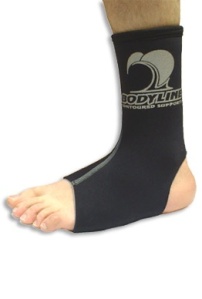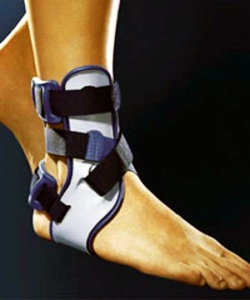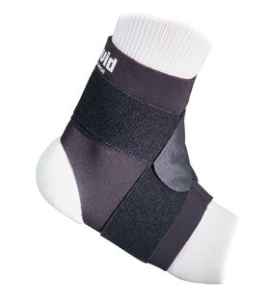Apoptosis means pre-programmed cell death. High dose steroids (corticosteroids which are commonly used to decrease swelling) have been implicated in causing this condition. When I first heard about this issue from chiropractors and physical therapists years ago, I though it was an alternative medicine marketing tactic. However, as I read more, it became clear that these negative effects of steroids on muscles, bones, cartilage, and ligament were quite real. I have summarized those here:
January 5, 2010
January 13, 2009
January 10, 2009
athletic ankle supports

As a doctor with an ankle problem, who is athletic, the best ankle brace I’ve found is the Malleoloc. However, if you have an ankle problem like I did, why not ditch the ankle supports? There are now new treatments where they inject your own stem cells into the ankle ligament tears to heal the damage. This way you avoid athletic ankle supports and surgery! This procedure should allow you to get rid of the athletic ankle supports for good. In this minor procedure, your own adult stem cells are grown to larger numbers. These repair cells are then injected into your torn ankle ligaments. After this cutting edge procedure, you can wear an athletic ankle support for a few weeks, but continue working out while the ligaments mend. You get to ditch the athletic ankle supports after just a month. Why do these injections instead of supports? An unstable ankle eventually damages the cartilage in the ankle and leads to early arthritis. So what’s a little ankle pain now, will be an arthritis problem in the future, unless you heal the ankle ligaments.
basketball ankle supports
As a doctor with an ankle problem, who plays basketball, the best ankle brace I’ve found is the Malleoloc. However, if you have an ankle problem like I did, why not get rid of the brace? There are now new treatments where the doctor injects your own stem cells into the ankle ligament tear to heal the damage. This way you avoid braces and surgery! This procedure should allow you to get rid of the basketball ankle supports for good. In this procedure, your own adult mesenchymal stem cells are isolated and then grown to larger numbers. These healing repair cells are then injected into your torn ankle ligaments. After this cutting edge procedure, you can wear a basketball ankle support for a few weeks, but continue playing and working out while the ligaments heal. Maximum healing is 6-12 weeks. You can come out of the basketball ankle supports after just a month. Why go through all of this? An unstable ankle eventually damages the cartilage in the ankle and leads to early arthritis. So what’s a mild pain in the ankle now, will be big arthritis in 20 years, unless you get the ankle ligaments fixed.
Mcdavid elastic ankle braces
As a doctor with an ankle problem, I like most of the Mcdavid elastic ankle braces that use both a hard shell component to add stability and elastic to allow movement. However, if you have an ankle problem like mine, why not get rid of the brace? New non-surgical treatments where the doctor injects your own stem cells into the ankle ligament tear to heal it should allow you to get rid of the Mcdavid elastic ankle brace for good. In this procedure, your own adult mesenchymal stem cells are isolated and then grown to bigger numbers. They are then injected under x-ray guidance into your torn ankle ligaments. After this break-through procedure, you can wear a brace for a few weeks, but continue playing and working out while the ligaments heal. Maximum healing is 6-12 weeks. You can come out of the Mcdavid elastic ankle brace after just a month. Why go through all of this? An unstable ankle eventually damages the cartilage in the ankle and leads to early arthritis. So what’s a pain in the ankle now, will be severe arthritis in 20 years, unless you get the ankle ligaments fixed. Think of these ligaments as duct tape that holds your ankle bones together. When that duct tape is torn, it needs to be fixed, not braced.
Ankle support in london?
As a physician, you might say that I have an American MD specializing in Regenerative Medicine and a “doctorate of hard knocks” in ankle braces. When I came across people searching for “Ankle support in london” I had to throw in my two cents. I don’t live in London, far from it, I’m in beautiful Boulder, Colorado. If you’re looking for an ankle support brace, I can tell you first hand that I’ve tried them all. The winner? The Malleoloc. However, my quest for the perfect ankle support didn’t end there, I then tried prolotherapy which allowed me to get rid of the ankle support brace. This technique involves injecting substances into the ankle ligaments to kick off an inflammatory healing response. This worked pretty well, even allowed me to take a run every once in a blue moon. What would I do today instead of the ankle support? I’d try this cutting edge procedure where they inject your won stem cells into the ankle ligaments to heal and repair the damage. The video below shows a patient where this was done in the U.S.:
January 6, 2009
recovery time shoulder surgery
As a doctor, recovery time from shoulder surgery can be prolonged. The problem is that the severe degree of immobilization that’s needed (that big blue pillow) makes that arm/hand useless. Is there a better way? Well, if you have a rotator cuff tear or ligament tear, newer and much less invasive methods of treatment may be the answer, as with less trauma from the procedure comes faster recovery times (read no blue pillow). How can this be possible? Trade the scapel for a needle. Rather than trying to sew ligaments back together or sewing a torn shoulder tendon, get the patient’s own stem cells to repair the damge. The doctor simply places the cells in the damaged area with an injection. Little trauma, little recovery. Sounds like a science fiction novel? Not really, as this procedure using your own stem cells to repair the shoulder damage is now being used reduce recooperation times. No surgery, less recovery.
January 4, 2009
Ligament Tear Symptoms
What are ligament tear symptoms? Think of ligaments as the duct tape that holds your bones and joints together. What happens when the duct tape gets stretched or gets torn? In this case, the duct tape (your ligaments) don’t hold the joint together, allowing for too much movement. While the area of the ligament tear can hurt and swell, once that initial several weeks of healing is over, if the duct tape hasn’t mended completely, the joint can be left unstable (read moving around too much). This instability can cause popping, clicking, and/or further swelling and pain in the joint. Over a few months to years, this can cause arthritis to develop much more quickly. How do you fix this ligament issue? Surgery is a possibility, but a bit more traumatic than the repair needs to be in most instances. A newer method is injecting your own stem cells into the ligament to get it to heal. The ligament grades above show that grade 1 and 2 are when the ligament is stretched or partially torn, grade 3 is completely torn. This stem cell treatment works best in grades 1 and 2. If you have a grade 3 tear, then surgery may be the only answer at this point.
Torn Ankle Ligament
The outside (lateral) ankle ligaments are the ones that are usually injured. These are the anterior and posterior (front and back) talo-fibular ligaments (the duct tape that holds the talus bone to the heel bone) and the calcaneo-fibular (the duct tape that holds the outside small leg bone (fibula) to the heel bone (calcaneus)). As a physician with a torn ankle ligament, there are three ways to fix a torn ankle ligament that hasn’t healed on it’s own:
1. Tendon graft surgery. The surgeon will take a tendon from the foot and sew it into place to substitute for a torn ankle ligament. The surgeon may also sew up any partial tears in any of the ankle ligaments. There are tow big downsides. The first is that this is a tight space and getting an arthroscope into the ankle can by itself cause some tissue damage. The second is that the tendon graft may end up either causing biomechanical issues (you need all of your tendons, so borrowing one from another spot may cause problems) or it can be placed too tightly and cause further ankle arthritis.
2. Prolotherapy. This is the injection of substances to cause a brief inflammatory healing reaction in the ligaments. For more information on prolotherapy.
3. Percuteneous stem cell assisted repair. This is where the doctor takes the patients own stem cells, grows them in a lab over a few weeks to bigger numbers, and then injects them back into the torn ligaments to repair the tears. This is the future of dealing with this problem and has just become available in the US. For a vido on the subject, see below:
January 2, 2009
Torn Tendon in Foot
Torn Tendon in Foot. Tendons are the cords that attach muscles to bone. In the foot, there are many tendons broken down into a couple of categories based on how they move the foot. These are tendons that plantar flex (foot pointed down), dorsiflex (toes and foot moving up), pronate and/or invert (bottom of foot points to other foot), and supinate and/or evert (bottom of foot points to the outside). A tear in a foot tendon is usually due to either an injury or overuse. For example, a tear in the tibialis anterior tendon can be due to too much force on the tendon as it tries to keep the foot from slapping on the ground. This type of tear is also usually caused by weakness in the tibialis anterior muscle (front of the shin) from a chronic low back pinched nerve. This muscle helps us control the foot as we walk. As the muscle gets weaker, the tendon gets beaten up trying to keep the foot from slapping while walking. In addition, the extensor hallicus longus (EHL) can get worn out trying to help the weak tibialis anterior muscle. Fixing a torn tendon in the foot can sometimes involve surgery, but newer non-surgical methods are much more promising. The newer treatments for torn tendons involve injecting the patient’s own stem cells into the tendon so that they can repair the damage. This is a full activity or a minimal downtime procedure, unlike surgery.





